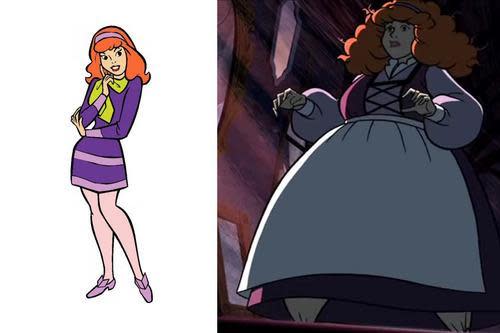New 'Scooby-Doo' Movie 'Curses' Daphne From Size 2 to Size 8

Photo by Warner Bros.
The latest Scooby Doo mystery is scary — but not because of the usual monsters, ghosts, and bad guys. “Scooby-Doo! Frankencreepy,” the latest direct-to-video animated installment featuring the mystery-solving and crime-fighting gang, follows Scooby, Shaggy, Fred, Velma, and Daphne to Transylvania, Pennsylvania, where they are going to check out the castle that Velma has inherited from her great-great-uncle Dr. Von Dinkenstein. Obviously, hijinks ensue, and when Daphne comes face-to-face with the bad guy, she is “cursed” with losing the thing that she holds most dear: her small frame. With a simple hex, the cartoon character instantaneously balloons from a size 2 to a (cover your eyes!) size 8.
Considering the average clothing size American women wear is a size 14 (plus-size is considered anything over 12) and that, according to the Centers for Disease Control and Prevention, the average woman in the United States is about 5’4” and weighs 166 pounds, being a size 8 shouldn’t be considered the worst thing that could possibly happen to Daphne, or any woman for that matter. What if something horrible happened to her, her parents, or the rest of the Scooby Doo gang? What about losing the job that she’s held since the show premiered in 1969? All of those circumstances would be measurably worse than gaining weight, right?

Daphne’s curse has sparked a conversation on social media. One Twitter user wrote, “I must be cursed too. Such nonsense,” and another said, “An 8 is smaller than I am; they drew her 2x bigger. So many things wrong here.” And Tom Burns of the blog The Good Men Project said, “It’s sad to think that my daughter can’t even watch a cartoon about a dog solving mysteries without negative body stereotypes being thrown in her face.” Considering that children start dieting as young as 10, according to a recent study, it’s especially important that what’s being displayed to children in the media portrays healthy messages about body image.
Daphne’s personality throughout the cartoon’s nearly half-century-long run has consistently been seeded with vapidity and selfishness, but the way to identify these flaws, solve them, and teach a lesson in front of an adolescent audience doesn’t require fat-shaming. Instead, as Burns points out, why wouldn’t the storytellers “cover her in hair and fangs and turn her into a wolf-girl? Why not give her a third eye, green skin, a tail?”
Warner Bros., the production company behind the animation, said in a statement to the Huffington Post that it is always sensitive to displaying themes of obesity and self-image, especially when the franchise’s target audience is children and families. “The loss of Daphne’s regular appearance is proven to be a superficial thing, and not what actually matters the most to her.”
The statement also notes that Daphne’s longtime love, Fred, “didn’t even notice a change and that she always looks great to him.” That message could be the worst of all — that a woman’s self-esteem and acceptance of her body and looks comes from a man’s approval, not from within.
As one Twitter user succinctly put it: “Scooby Doo taught us that the real monsters are humans and if that is not deep, I don’t know what is.” Welp.

